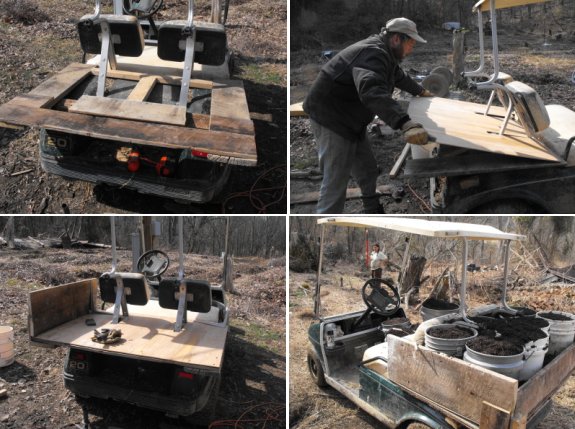
Home made golf cart dump box

Total cost on this home made
golf cart dump box was just over 5 bucks thanks to using scrap
wood from the old house.
It expands the back hauling
capacity of the golf cart from 2 buckets to 7, with about 3 buckets
worth in between the cracks.
Next up is a wooden rack to
take advantage of some space up front.
Want more in-depth information? Browse through our books.
Or explore more posts by date or by subject.
About us: Anna Hess and Mark Hamilton spent over a decade living self-sufficiently in the mountains of Virginia before moving north to start over from scratch in the foothills of Ohio. They've experimented with permaculture, no-till gardening, trailersteading, home-based microbusinesses and much more, writing about their adventures in both blogs and books.
Want to be notified when new comments are posted on this page? Click on the RSS button after you add a comment to subscribe to the comment feed, or simply check the box beside "email replies to me" while writing your comment.

Were milk floats ever used in the US? If so, you should look into acquiring one. They were built to be stacked full of crates of filled glass milk bottles. That's quite a lot of carrying capacity.
BTW, be careful about not overloading your golf cart. Doing so might damage the engine and/or batteries. (depends on the type of motor and electronics used)
I'd never heard of milk floats, but now I wish they had them here!
Good point on maxing out the golf cart. Mark actually added on another five buckets or so to what he showed in the picture, and realized that it was making the back wheels rub on the wheel wells. Looks like there are definite limits there.
For traction often series-wound DC motors are used. These have the advantage of creating a huge torque when they are powered but not turning yet. The disadvantage is an extremely large current (only limited by the resistance of the windings) running through the motor at that time. This current generates a lot of heat in the windings, typically much more than the motor is capable of withstanding in sustained operation. As soon as the motor begins turning, back-emf will limit the current and therefore heat generation. This kind of motor is also frequently used as a starter motor for internal combustion engines because of its high start-up torque.
If such a motor gets stuck under power for some time, the large current will eventually overheat the engine and destroy the windings. A large sustained current also might damage the batteries. Normally I'd expect there to be a fuse in the circuit to protect the engine and batteries. But it wouldn't be the first time that some inventive person replaced a fuse by a piece of metal becaue the fuses blow up so often...